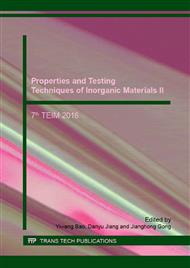[1]
C. Yan, D. Xue, Formation of Nb2O5 nanotube arrays through phase transformation, Adv. Mater. 20 (2008) 1055.
DOI: 10.1002/adma.200701752
Google Scholar
[2]
J. Liu, D. Xue, Thermal oxidation strategy tpwards porous metal oxide hollow architectures, Adv. Mater. 20 (2008) 2622.
DOI: 10.1002/adma.200800208
Google Scholar
[3]
C. Yan, D. Xue, Solution growth of nano- to microscopic ZnO on Zn, J. Crystal Growth 310 (2008) 1836.
DOI: 10.1016/j.jcrysgro.2007.10.060
Google Scholar
[4]
T. Gao, T.H. Wang, Synthesis and properties of multipod-shaped ZnO nanorods for gas-sensor applications. Appl. Phys. A 80 (2005) 1451.
DOI: 10.1007/s00339-004-3075-2
Google Scholar
[5]
S. Anandan, A. Vinu, T. Mori, N. Gokulakrishnan, P. Srinivasu, V. Murugesan, K. Ariga, Photocatalytic degradation of 2, 4, 5-trichlorophenol using lanthanum doped ZnO in aqueous suspension. Catal. Commun. 8 (2007) 1377.
DOI: 10.1016/j.catcom.2006.12.001
Google Scholar
[6]
X.L. Chen, B.H. Xu, J.M. Xue, Y. Zhao, C.C. Wei, J. Sun, Y. Wang, X.D. Zhang, X.H. Geng, Boron-doped zino oxide thin films for large-area solar cells grown by metal organic chemical vapour deposition. Thin Solid Films 515 (2007) 3753.
DOI: 10.1016/j.tsf.2006.09.039
Google Scholar
[7]
H. Chen, A.D. Pasquier, G. Saraf, J. Zhong, Y. Lu, Dye-sensitized solar cells using ZnO nanotips and Ga-doped ZnO films. Semicond. Sci. Technol. 23 (2008) 045004.
DOI: 10.1088/0268-1242/23/4/045004
Google Scholar
[8]
A. Moulahi, F. Sediri, N. Gharbi, Hydrothermal synthesis of nanostructured zinc oxide and study of their optical properties, Mater. Res. Bull. 47 (2012)667–671. ].
DOI: 10.1016/j.materresbull.2011.12.027
Google Scholar
[9]
X.Q. Wei, B.Y. Man, M. Liu, C.S. Xue, H.Z. Zhuang, C. Yang, Blue luminescentcenters and microstructural evaluation by XPS and Raman in ZnO thin films annealed in vacuum, N2and O2, Physica B 388 (2007) 145–152.
DOI: 10.1016/j.physb.2006.05.346
Google Scholar
[10]
K.T. Roro, J.K. Dang begnon, S.S. Varaya, A.W.R. Leitch, J.R. Botha, Influence of metal organic chemical vapor deposition growth parameters on the luminescent properties of ZnO thin films deposited on glass substrates, J. Appl. Phys. 103 (2008).
DOI: 10.1063/1.2873872
Google Scholar
[11]
K.T. Roro, J.K. Dangbegnon, S.S. Varaya, A.W.R. Leitch, J.R. Botha, Influence of metal organic chemical vapor deposition growth parameters on the luminescent properties of ZnO thin films deposited on glass substrates, J. Appl. Phys. 103 (2008).
DOI: 10.1063/1.2873872
Google Scholar


